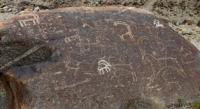Вы здесь
Petroglyphs of South-Western Turkmenistan.

The Best Turkmenistan Petroglyphs Tours.
“I've known rivers:
I've known rivers ancient as the world and older than the flow of human blood in human veins. My soul has grown deep like the rivers”
Langston Hughes.
Petroglyphs Visitor Guide Turkmenistan.
The Atrek-Sumbar region is in the extreme south of Western Turkmenistan in the Atrek and Sumbar River basins. The Atrek River starts in the southern slopes of Western Kopet-Dag in Iran and flows into the Caspian Sea.
The sources of the river are at 2,000m altitude. The largest Atrek tributary is Sumbar, fed by the Chandyr River in its upper reaches. This is an area of arid subtropics. The southern slopes of the Chandyr valleys are overgrown with subtropical vegetation, while barren cliffs – gray, green, and brown limestone – stand out on the northern river bank.
The natural landscape is strikingly monotonous and dismal. There is no water along these barren slopes. The land is usually rocky and dry. Only in spring, during the rainy season when mudslides occur, the Chandyr and Sumbar turn into tumultuous streams.
The Chandyr valley is drier than the Sumbar valley, with fewer springs; in the summer, the river dries out along its entire course. Small flood-plains and terraces above flood-plains with sedge vegetation on meadow boggy soil form the upper reaches of the Sumbar River.
Oases are located on light and dark sierozem (grey desert soil) of the Sumbar and Chandyr valleys. The Chandyr starts in Iran and, in a more favorable ancient climate, this region could have been used as part of caravan routes.
The Monzhukly Range (1,000 - 1,280m above sea level) protects the Chandyr valley from northern winds. Summers are hot, but not stiflingly sultry. Winters are mild and it almost never snows in the valley; frosts are extremely rare.
Annual precipitation: 229mm. Average yearly temperature +17.1C degrees (Babayev, Batyrov, Lavrov, 1994). The vegetation of the Chandyr valley is characteristic of arid subtropics. Woods and shrubs related to groundwater mainly grow on the bottoms of ravines and extend in a fine line along watercourses.
A series of annual ephemeral or perennial and more resistant grasses grow on open slopes. They are home to sagebrush, mausoleya, saltwort, tamarisk, southern reed, several types of alfalfa, thorny peas, blackberry, mushrooms and Turkmen hawthorn. In the spring, the valley vegetation is richer due to the prevalence of ephemeral and semi-ephemeral flora. In the summer, the grass cover becomes scanty.
The territory of Turkmenistan is a non-permanent habitat for a species of brown bear that comes from Northern Iran into Southwestern Kopet-Dag between Sumbar and Chandyr and is found in Koyne-Kesyra, Ay-Dere Gorge, and in gorges in the Chandy River valley.
Tigers are rare in Sumbar and Chandyr; the habitat of species and subspecies of caracal (carnivore order, cat family) includes Atrek, Sumbar, and the Chandyr river valley. In June 1975, a female leopard or panther with two cubs were observed in the Suyukli Gorge of the Chandyr valley.
In the 1950’s - 1960’s goitered gazelles were numerous in Southwestern Turkmenistan, but they are now gone. In the late XIXth century, francolin (order of fowl-like birds, pheasant family) inhabited the lower reaches of Chandyr. Large whip snakes, of the colubrid snakes family, sporadically occur in Sumbar, Chandyr and Atrek river valleys.
The valleys of the Sumbar and Chandyr rivers are home to cobra. The range of the Asiatic dormouse is limited by the Sumbar and Chandyr river valleys; lesser horseshoe bats are also present. Otters inhabit the Atrek and Sumbar river basins (Red Book 1985).
Authority:
Edjegul Muradova.
Photos by
Alexander Petrov.







